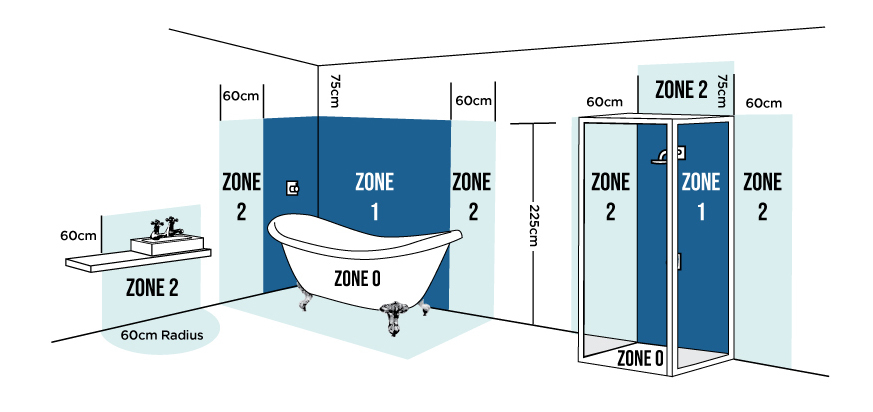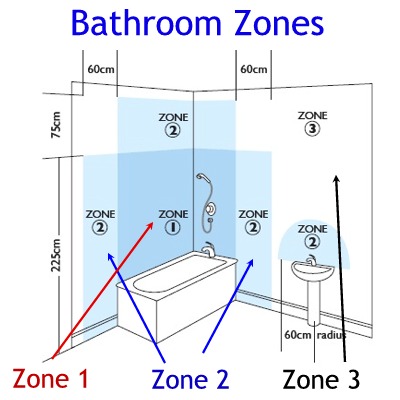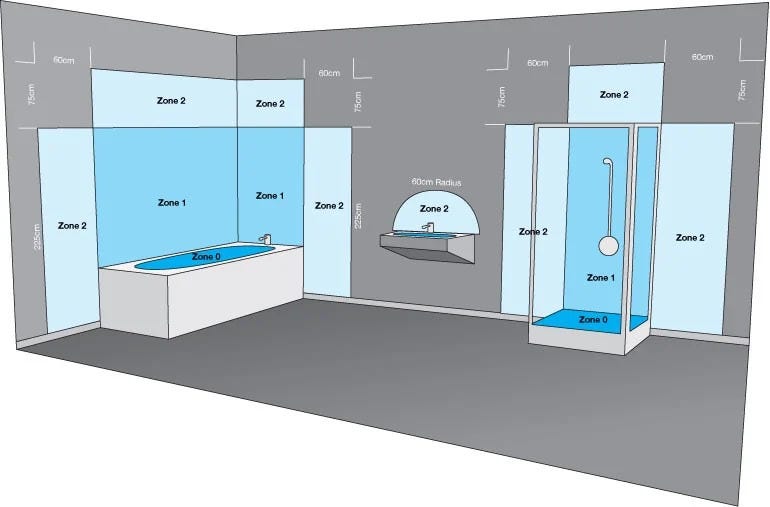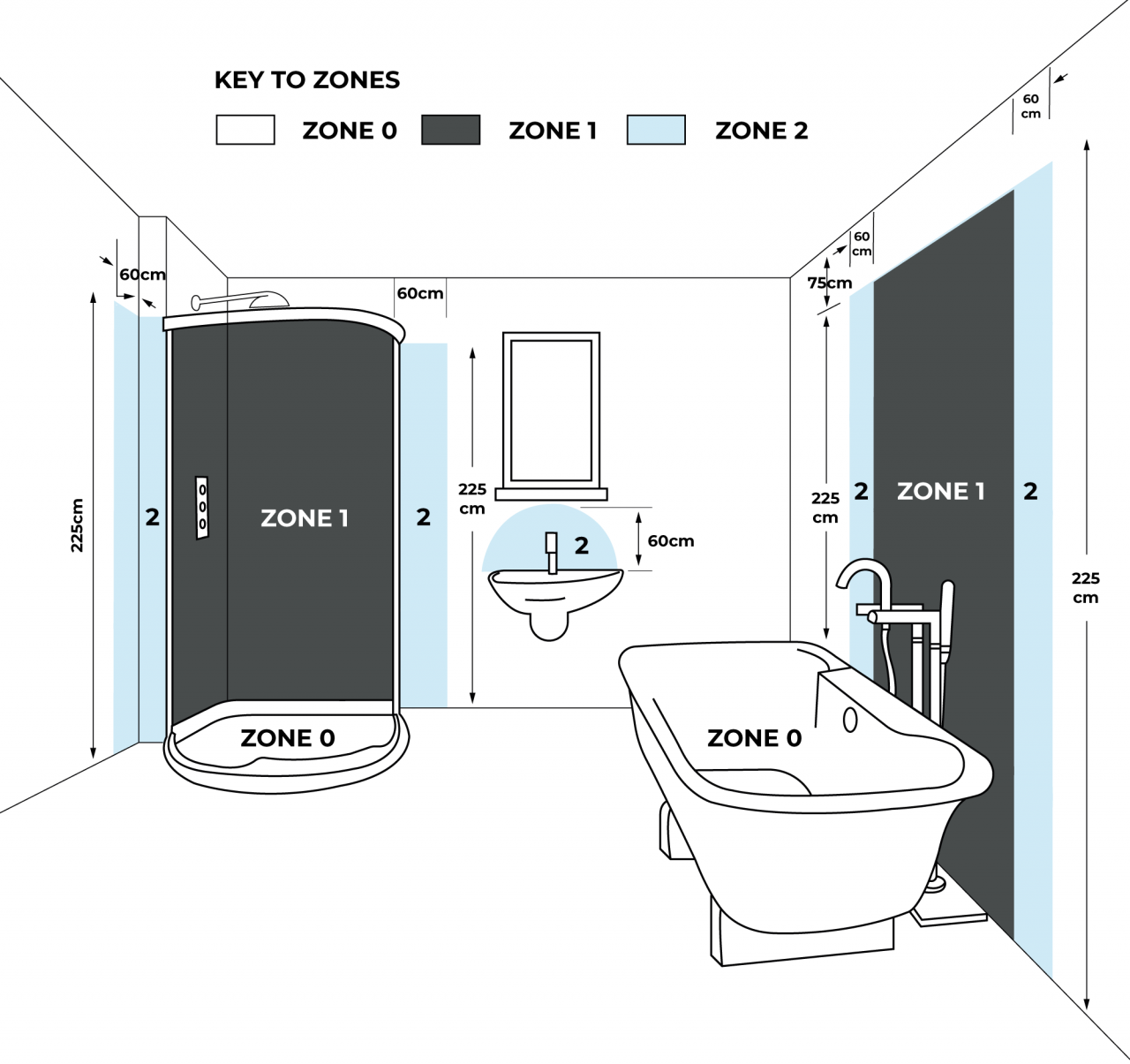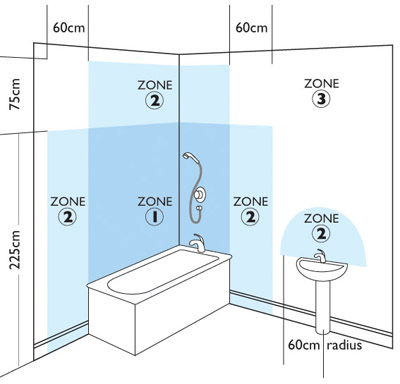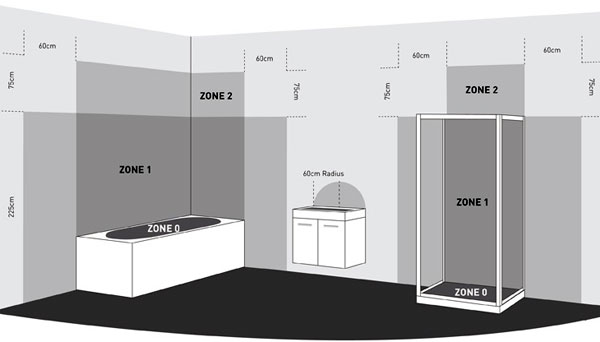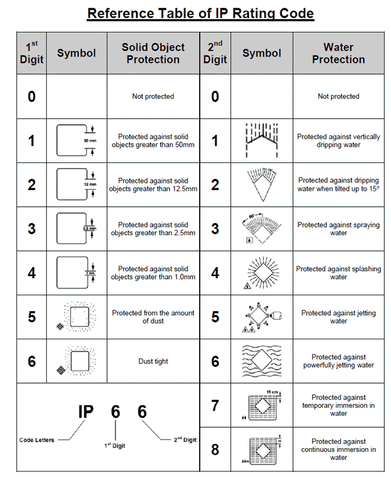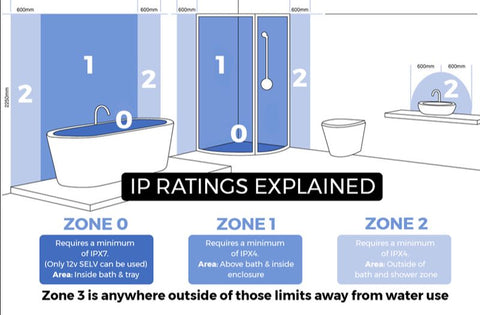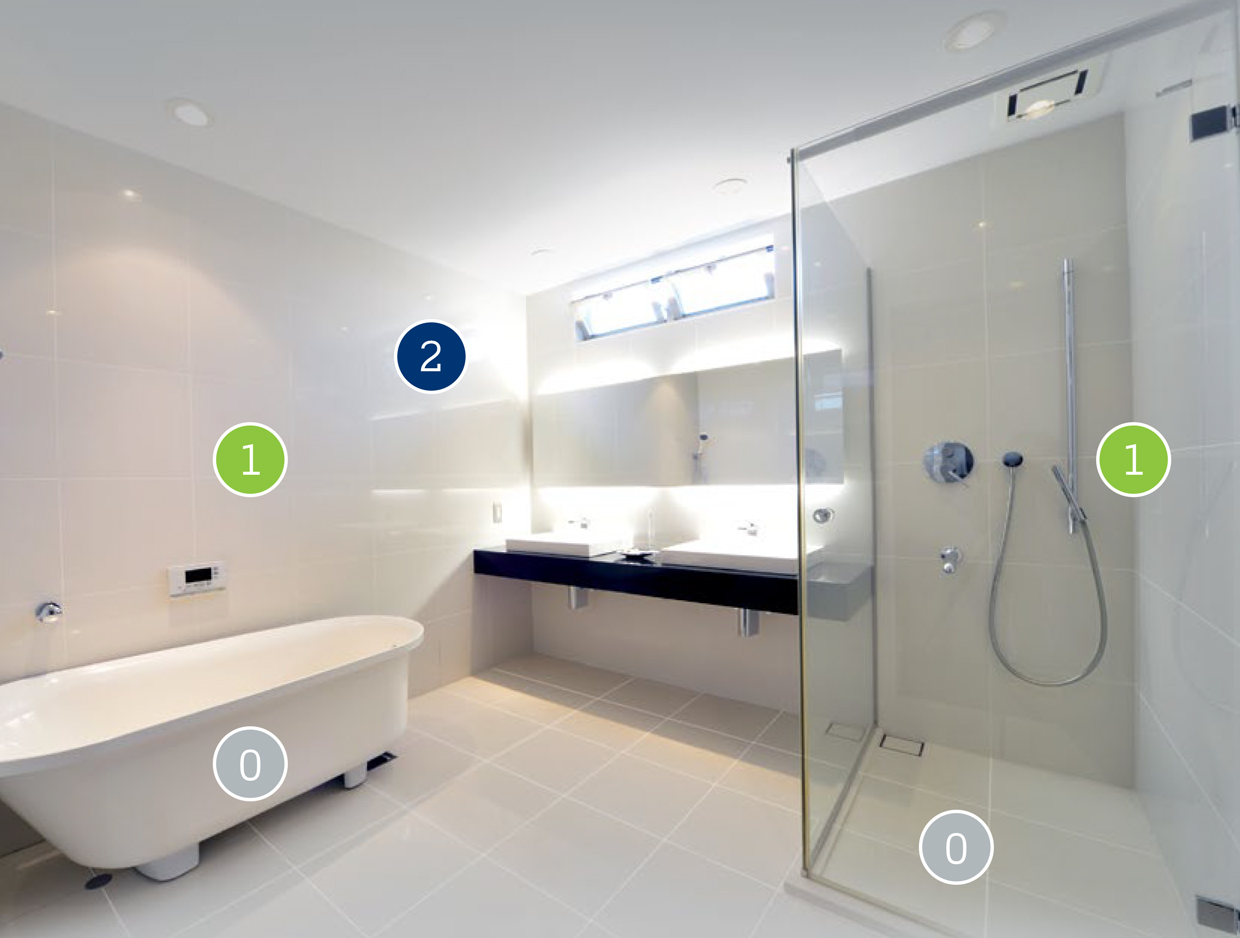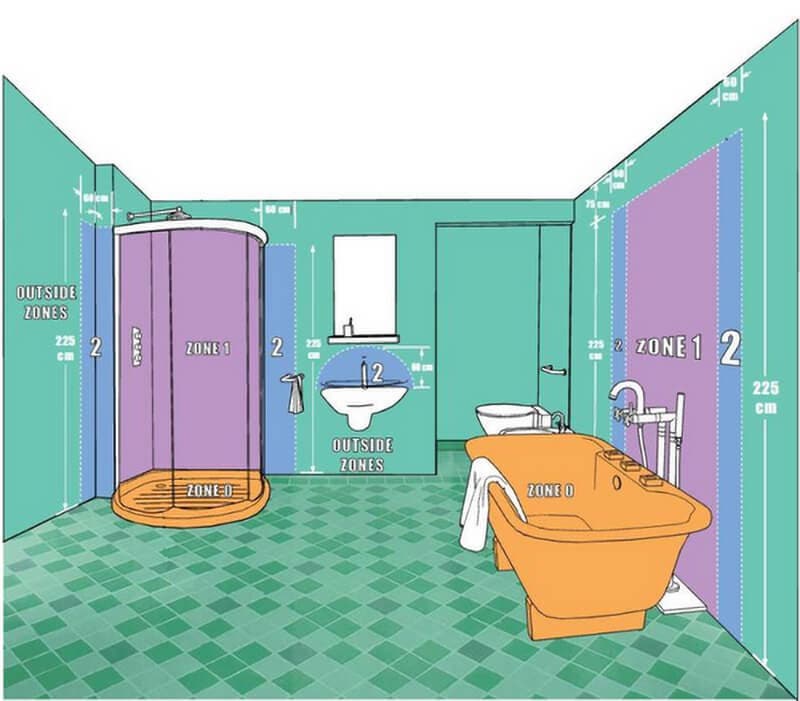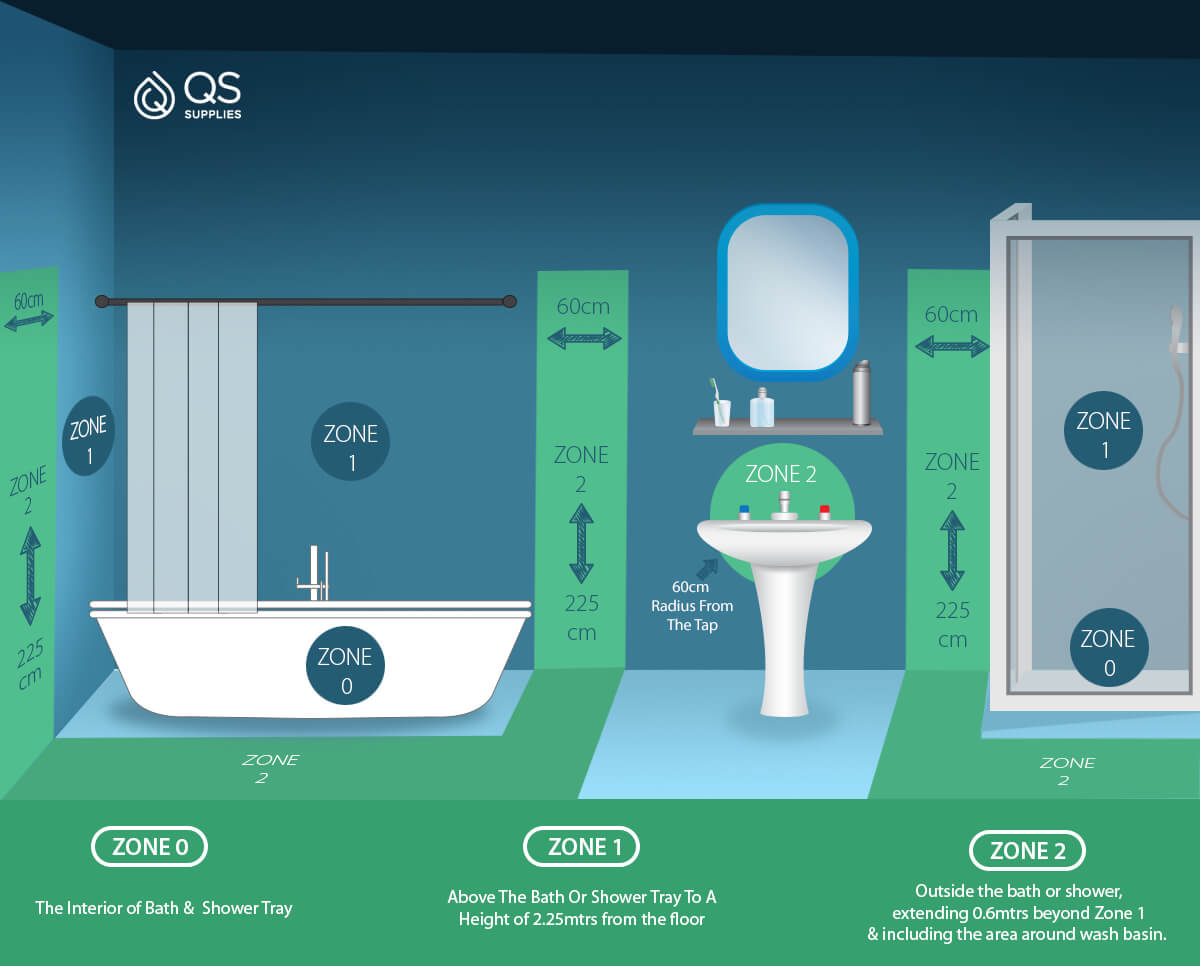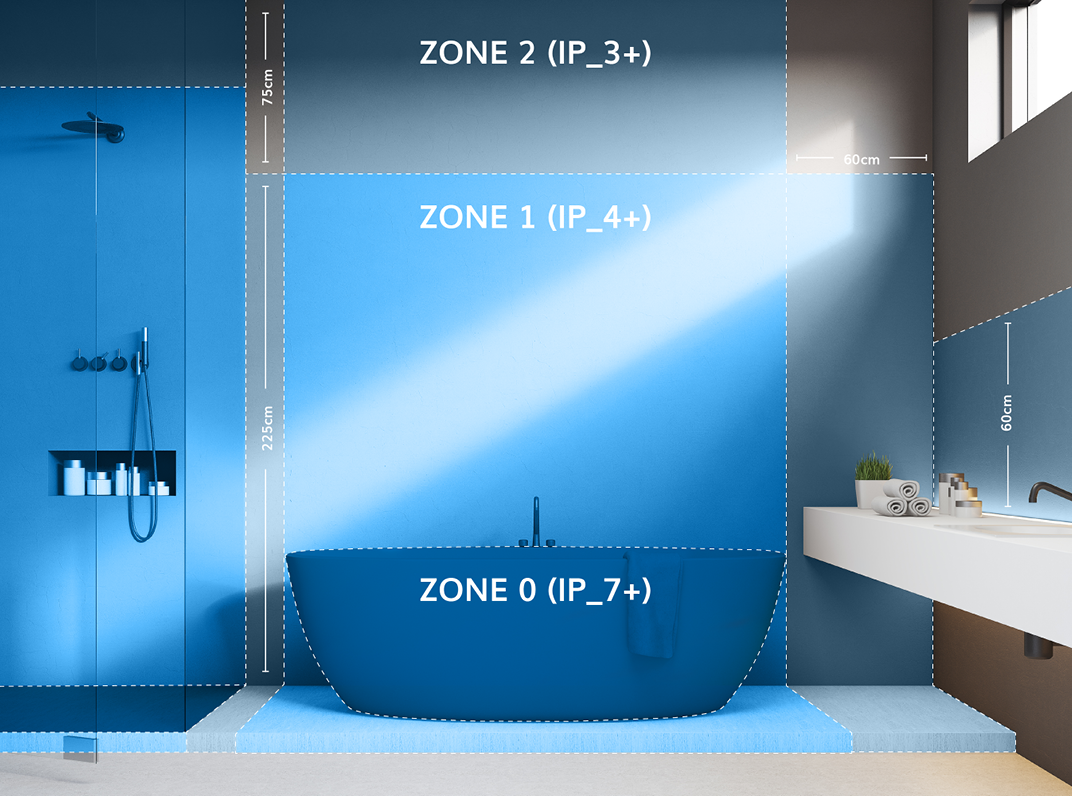Understanding Bathroom Lighting Zones
Bathroom lighting zones are a crucial aspect of bathroom design and safety. These zones help determine the type of lighting fixtures that can be installed in different areas of the bathroom based on their proximity to water sources and the risk of exposure to moisture. Understanding these zones is essential for creating a well-lit, functional, and safe bathroom space.
- Definition of Bathroom Lighting Zones: Bathroom lighting zones are designated areas within the bathroom that dictate the type of lighting fixtures that can be installed based on their proximity to water sources and the level of protection required against water exposure. These zones are outlined in electrical regulations to ensure safety and compliance with building codes.
- Purpose of Bathroom Lighting Zones: The primary purpose of bathroom lighting zones is to enhance safety by preventing the risk of electric shock or fire hazards in areas where water is present. By categorizing different areas of the bathroom into specific zones, homeowners and designers can choose appropriate lighting fixtures that meet safety standards and reduce the risk of accidents.
- Understanding Zone 0, 1, 2, and 3: Bathroom lighting zones are categorized into four main zones, each with its requirements and restrictions regarding the installation of lighting fixtures. Zone 0 is the area inside the bathtub or shower basin, while Zone 1 covers the area directly above the bathtub or shower up to a certain height. Zone 2 extends horizontally from the edge of Zone 1 and includes areas around the sink and bath. Zone 3 encompasses the rest of the bathroom space outside of Zones 0, 1, and 2.
- Considerations for Lighting Design: When designing the lighting layout for a bathroom, it’s essential to consider the specific requirements of each lighting zone. Task lighting, such as recessed lights or wall-mounted fixtures, is often used in Zones 1 and 2 to provide adequate illumination for activities like showering and grooming. In Zone 3, ambient lighting, such as ceiling-mounted fixtures or pendant lights, can be used to create a comfortable and inviting atmosphere.
- Compliance with Regulations: It’s crucial to ensure that all lighting fixtures installed in the bathroom comply with electrical regulations and safety standards. This includes using fixtures that are suitable for the specific bathroom lighting zone they are intended for and following installation guidelines provided by manufacturers and building codes.
- Flexibility in Design: While adhering to lighting zone regulations is essential for safety, there is still room for creativity and flexibility in designing a well-lit bathroom. By carefully selecting lighting fixtures that meet safety requirements while also complementing the overall design aesthetic, homeowners can create a functional and visually appealing bathroom space.
Importance of Bathroom Lighting Zones for Safety and Functionality
Bathroom lighting zones play a crucial role in ensuring safety and functionality within the bathroom space. These zones help determine the type of lighting fixtures that can be installed in different areas of the bathroom based on their proximity to water sources and the level of protection required against moisture exposure. Understanding the importance of these zones is essential for creating a well-lit and safe bathroom environment.
Preventing Electric Shock: One of the primary purposes of bathroom lighting zones is to prevent the risk of electric shock in areas where water is present. By categorizing different areas of the bathroom into specific zones and specifying the type of lighting fixtures that can be installed in each zone, homeowners and designers can reduce the risk of accidents and ensure electrical safety.
Minimizing Fire Hazards: In addition to preventing electric shock, bathroom lighting zones also help minimize the risk of fire hazards caused by water exposure to electrical components. By using lighting fixtures that are specifically designed for wet environments in zones where moisture is present, homeowners can mitigate the risk of fires and ensure the safety of their bathroom space.
Enhancing Visibility and Functionality: Proper lighting is essential for enhancing visibility and functionality within the bathroom space. By installing appropriate lighting fixtures in different areas of the bathroom based on their specific requirements, homeowners can ensure adequate illumination for tasks such as showering, grooming, and applying makeup, making the bathroom space more functional and user-friendly.
Compliance with Building Codes: Following bathroom lighting zone regulations is not only important for safety but also for compliance with building codes and regulations. By adhering to zoning requirements and using lighting fixtures that meet safety standards, homeowners can ensure that their bathroom space complies with electrical regulations and building codes, avoiding potential fines and penalties.
Creating a Comfortable and Inviting Atmosphere: In addition to safety and functionality, bathroom lighting also plays a significant role in creating a comfortable and inviting atmosphere. By carefully selecting lighting fixtures that provide the right balance of task lighting and ambient lighting, homeowners can create a warm and welcoming bathroom environment that enhances the overall aesthetic appeal of the space.
Increasing Property Value: A well-lit and safe bathroom space can significantly increase the value of a property. By investing in proper lighting fixtures and ensuring compliance with zoning regulations, homeowners can enhance the appeal and marketability of their homes, making them more attractive to potential buyers and increasing their resale value.
Differentiating Between Bathroom Lighting Zone 0, 1, 2, and 3
Bathroom lighting zones are categorized into four main zones, each with its requirements and restrictions regarding the installation of lighting fixtures. Understanding the differences between these zones is essential for selecting appropriate lighting fixtures that meet safety standards and comply with building codes. Below is a breakdown of each lighting zone and its specific requirements:
Zone 0: Zone 0 is the area inside the bathtub or shower basin. Lighting fixtures installed in Zone 0 must be specifically designed for immersion in water and must be low voltage (12 volts maximum). These fixtures must be connected to a residual current device (RCD) for added safety and protection against electric shock.
Zone 1: Zone 1 covers the area directly above the bathtub or shower up to a certain height. For a shower, Zone 1 extends vertically to a height of 2.25 meters from the floor of the shower or bathtub. Lighting fixtures installed in Zone 1 must be IPX4 rated, which means they are splash-proof and suitable for use in wet areas.
Zone 2: Zone 2 extends horizontally from the edge of Zone 1 and includes areas around the sink and bath. Lighting fixtures installed in Zone 2 must be IPX4 rated or higher and must be protected against water splashes from any direction. This includes recessed lights, wall-mounted fixtures, and ceiling-mounted fixtures.
Zone 3: Zone 3 encompasses the rest of the bathroom space outside of Zones 0, 1, and 2. Lighting fixtures installed in Zone 3 do not have specific IP rating requirements but should still be suitable for use in a bathroom environment where moisture may be present. This includes ambient lighting such as ceiling-mounted fixtures, pendant lights, and wall sconces.
Additional Considerations: In addition to IP ratings, it’s essential to consider other factors such as installation height, proximity to water sources, and the type of bulb used when selecting lighting fixtures for each zone. LED bulbs are often recommended for bathroom lighting due to their energy efficiency and low heat output.
Tips for Choosing the Right Lighting Fixtures for Each Bathroom Zone
Selecting the right lighting fixtures for each bathroom zone is essential for ensuring safety, functionality, and compliance with building codes. By understanding the specific requirements of each lighting zone and following these tips, homeowners can choose appropriate lighting fixtures that meet their needs and enhance the overall design of their bathroom space.
Consider IP Ratings: When selecting lighting fixtures for bathroom zones, consider the IP (Ingress Protection) rating of the fixture, which indicates its level of protection against moisture and water exposure. Choose fixtures with appropriate IP ratings for each zone based on their proximity to water sources and the risk of exposure to moisture.
Choose LED Bulbs: LED bulbs are highly recommended for bathroom lighting due to their energy efficiency, long lifespan, and low heat output. LED bulbs are less prone to damage from moisture and can withstand frequent on/off cycles, making them ideal for use in wet environments like bathrooms.
Opt for Dimmable Fixtures: Dimmable lighting fixtures offer flexibility in adjusting the brightness levels according to your needs and preferences. Consider installing dimmable fixtures in areas where task lighting is required, such as above the mirror or vanity, to provide optimal illumination for grooming and makeup application.
Select Suitable Fixture Types: Choose lighting fixtures that are suitable for the specific requirements of each bathroom zone. For example, recessed lights or flush-mounted ceiling fixtures are ideal for Zones 1 and 2, where water exposure is possible. Wall-mounted fixtures or pendant lights can be used in Zone 3 to provide ambient lighting and enhance the overall aesthetic of the space.
Ensure Proper Installation: Proper installation of lighting fixtures is crucial for ensuring safety and functionality within the bathroom space. Follow manufacturer guidelines and building codes when installing fixtures in each zone, and consider hiring a licensed electrician for complex installations to ensure compliance with electrical regulations.
Coordinate Fixture Styles: Coordinate the styles and finishes of lighting fixtures with the overall design aesthetic of your bathroom space. Choose fixtures that complement the existing decor and enhance the visual appeal of the room while providing adequate illumination for various activities.
Practical Considerations and Lighting Design Ideas for Various Bathroom Zones
Designing a well-lit and functional bathroom space requires careful consideration of practical factors and creative lighting design ideas for each lighting zone. By incorporating these practical considerations and lighting design ideas, homeowners can create a visually appealing and functional bathroom environment that meets their needs and enhances their daily routines.
Task Lighting in Zones 1 and 2: Install task lighting fixtures such as recessed lights, wall-mounted fixtures, or vanity lights in Zones 1 and 2 to provide adequate illumination for activities like showering, grooming, and applying makeup. Consider placing vanity lights on either side of the mirror for even and shadow-free lighting.
Ambient Lighting in Zone 3: Incorporate ambient lighting fixtures such as ceiling-mounted fixtures, pendant lights, or wall sconces in Zone 3 to create a comfortable and inviting atmosphere. Consider installing dimmable fixtures to adjust the brightness levels according to your needs and preferences.
Mirror Lighting: Install lighting fixtures above or around the mirror to provide optimal illumination for grooming and makeup application. Consider using LED strip lights or vanity lights with diffused shades to minimize glare and provide even lighting across the face.
Accent Lighting: Add accent lighting fixtures such as LED strip lights or recessed lights to highlight architectural features or decorative elements in the bathroom space. Consider installing accent lights under cabinets or shelves to illuminate dark corners and add visual interest to the room.
Natural Lighting: Maximize natural lighting in the bathroom by incorporating windows, skylights, or light tubes to bring in natural light and create a bright and airy atmosphere. Consider using sheer curtains or frosted glass to maintain privacy while allowing natural light to filter into the space.
Smart Lighting Controls: Incorporate smart lighting controls such as dimmer switches, motion sensors, or programmable timers to enhance convenience and energy efficiency. Smart lighting controls allow you to adjust lighting settings remotely or automate lighting schedules based on your daily routines.
Layered Lighting Design: Create a layered lighting design by combining different types of lighting fixtures to provide both functional and decorative illumination. Layered lighting design adds depth and dimension to the bathroom space while ensuring adequate lighting for various activities.
Waterproof Lighting Fixtures: Choose waterproof lighting fixtures with appropriate IP ratings for areas where water exposure is possible, such as above the bathtub or shower. Waterproof fixtures are designed to withstand moisture and provide safe and reliable illumination in wet environments.
What are bathroom lighting zones, and why are they important?
Bathroom lighting zones are designated areas within the bathroom that dictate the type of lighting fixtures that can be installed based on their proximity to water sources and the risk of exposure to moisture. They are important for safety, as they help prevent electric shock and minimize fire hazards in areas where water is present.
How are bathroom lighting zones categorized?
Bathroom lighting zones are categorized into four main zones: Zone 0, Zone 1, Zone 2, and Zone 3. Each zone has specific requirements and restrictions regarding the installation of lighting fixtures based on their proximity to water sources and the level of protection required against moisture exposure.
What types of lighting fixtures are suitable for each bathroom lighting zone?
Lighting fixtures suitable for each bathroom lighting zone vary depending on the level of protection required against moisture exposure. For example, fixtures installed in Zone 0 must be specifically designed for immersion in water and low voltage, while fixtures installed in Zone 3 should be suitable for use in a bathroom environment where moisture may be present.
Do all lighting fixtures need to be IP-rated for use in the bathroom?
Yes, it is recommended to use lighting fixtures that are IP-rated for use in the bathroom, especially in areas where water is present. IP (Ingress Protection) ratings indicate the degree of protection against water and solid particles, with higher ratings providing better protection against moisture exposure.
Can I install lighting fixtures outside of their designated bathroom lighting zones?
It is not recommended to install lighting fixtures outside of their designated bathroom lighting zones, as this may pose a safety risk. It is essential to follow zoning regulations and choose lighting fixtures that meet safety standards and comply with building codes to ensure a safe and functional bathroom environment.
Are there any specific safety measures I should take when installing lighting fixtures in the bathroom?
Yes, when installing lighting fixtures in the bathroom, it is essential to use fixtures that are specifically designed for wet environments and to ensure proper grounding and wiring. Additionally, using a residual current device (RCD) can provide added protection against electric shock in areas where water is present.
Can I use LED lighting fixtures in the bathroom?
Yes, LED lighting fixtures are suitable for use in the bathroom and are often recommended for their energy efficiency and long lifespan. When choosing LED fixtures for the bathroom, make sure they are suitable for wet environments and have the appropriate IP rating for the designated lighting zone.
How can I ensure compliance with electrical regulations and building codes when installing lighting fixtures in the bathroom?
To ensure compliance with electrical regulations and building codes, it is essential to consult local building codes and regulations and hire a qualified electrician to install lighting fixtures in the bathroom. Additionally, choosing fixtures that meet safety standards and following manufacturer guidelines for installation can help ensure compliance with regulations.
Bathroom Lighting Regulations – Bathroom Zones u0026 IP Ratings Explained
What Are IP Ratings u0026 Zones For Bathrooms │The Light Yard
Pendant lighting: use dramatic IP rated lighting as your
Understanding Bathroom Lighting Zones
IP Ratings and Rules for Lighting and Power in the Bathroom
Bathroom Electric Zones in the UK and IP Rating Explained QS
Australian Bathroom Lighting Requirements, ZONES And IP Ratingsu003c/a
Decor Kitchens and Interiors: Bathroom Zones
Related Posts:

